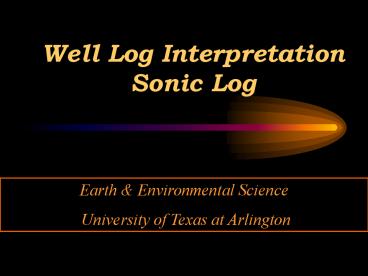Well Log Interpretation Sonic Log - PowerPoint PPT Presentation
1 / 8
Title:
Well Log Interpretation Sonic Log
Description:
The sonic transit time depends on the lithology, porosity and fluids in the pore ... Sonic Log. If hydrocarbons are present, fs must be reduced by a factor of ... – PowerPoint PPT presentation
Number of Views:6429
Avg rating:5.0/5.0
Title: Well Log Interpretation Sonic Log
1
Well Log InterpretationSonic Log
Earth Environmental Science University of
Texas at Arlington
2
Sonic Log
The sonic log measures the time, Dt in
microseconds, it takes a compressional wave to
travel through 1 of rock. The units are msec/ft,
the inverse of velocity. The sonic velocity can
be related to seismic velocity.
3
Sonic Log
The sonic transit time depends on the lithology,
porosity and fluids in the pore spaces. It also
assumes a homogeneous distribution of porosity.
Vuggy and fracture porosity give spurious results.
4
Sonic Log
- To compute porosity from a sonic log, the
following information is needed - Dtma transit time through the matrix alone
- Dtfl transit time through the fluid alone
- Dtlog the measured transit time from the log.
5
Sonic Log
There are two equations commonly used to compute
sonic velocity Wyllie time averaged
Raymer-Hunt-Gardner (RHG)
6
Sonic Log
Cp, a compaction factor, 1 for consolidated
sediments. For unconsolidated sediments
7
Sonic Log
If hydrocarbons are present, fs must be reduced
by a factor of 0.7 (gas) or 0.9 (oil)
8
Sonic Log Assignment
Using the sonic log on the left, make a
spreadsheet that computes fs for lms, dol and ss
at depths of 9300 and 9369 using both the
Wyllie and RHG equations. Label each parameter.































